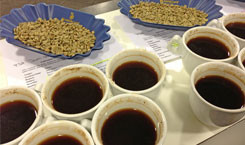Coffee Cupping - what does my coffee taste like?
What is coffee cupping? And how does it work? Here, we’ll explain to you, how a real professional does it and what you have to keep in mind when cupping your favorite espressos.
What is coffee cupping?
As you probably guessed, the word „cupping“ comes from the term cup. It is used to describe a comparative tasting of different coffee roasts. On its way from the farm to the cup, the coffee passes many different stops and all along the way small amounts are roasted and sampled by cupping it. Especially for importers and roasters, cupping coffee is a reliable way of telling the quality and character of the coffee, and determining the value of the batch they are about to buy. For the roaster, sample roasting and cupping is also essential to define the perfect, individual roasting profile for each batch of coffee.
How does a cupping work?
There is many different ways of preparing and performing a coffee cupping. To assess the actual quality of the raw coffee, a light and mild roasting is preferred, sometimes even lighter than a filter coffee roast. It's important to maintain all the coffees properties without covering them with too many roasting aromas.
When ascertaining a roasting profile or cupping already roasted coffees, the coffee is previously roasted all the way. Then, the coffee is ground and brewed. For a successful cupping its important to brew and grind every cup in the exact same way. Differences in grinding degree, amount of coffee and water temperature should stay the same, they could otherwise falsify the comparison.
At first, the scent of the brewed coffee is assessed. About four minutes after bowing the coffee, it should be tasted. With a special cupping spoon, the crema is breached and the smell and all its aromas are describes. Now, just like when tasting wine, a small sip slurped form the cup, loud smacking and slurping is totally appropriate, this way, the aromas of the coffee get blended with air, making them more present for tongue and nose.
More than one thousand flavorings
Since the human tongue can only differentiate between sweet, sour, bitter and salty, a good nose is essential for assessing the profile of a coffee. Professionals rate aroma, acidity, body and aftertaste of each roast. The most common sensory vocabulary is set by the international coffee organization ICO. Depending on wether you’re cupping espresso, filter coffee, ristretto or something entirely different, some properties are considered more desirable than others. Espresso shouldn’t be too sour, filler coffee not too bitter and the ristretto as robust and strong as possible. If you want to try a home cupping for yourself, have a look for a „flavor wheel“, it will help you discover lots and lots of hidden characteristics of your favorite coffee!

